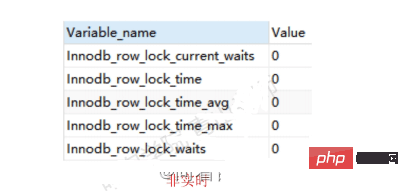
Recommended study:mysql video tutorial
When we use locks, there is a problem that needs to be paid attention to and avoided. We know that exclusive locks have mutually exclusive characteristics. When a transaction or a thread holds a lock, it will prevent other threads from acquiring the lock. This will cause blocking waiting. If you wait in a loop, it may cause a deadlock.
We need to analyze this problem from several aspects. One is why the lock is not released, the second is what to do if it is blocked, and the third is how deadlock occurs and how to avoid it.
Review: When will the lock be released?
Transaction ends (commit, rollback);
The client connection is disconnected.
If a transaction has not released the lock, how long will other transactions be blocked? Will they wait forever?
If so, when concurrent access is relatively high, if a large number of transactions are blocked due to Failure to obtain the required lock immediately and hanging will occupy a lot of computer resources, cause serious performance problems, and even drag across the database.
Are you afraid of this mistake online?
[Err] 1205 - Lock wait timeout exceeded; try restarting transaction
MySQL has a parameter to control the waiting time to acquire the lock, the default is 50 seconds.
show VARIABLES like "innodb_lock_wait_timeout";
For deadlock, no matter how long you wait, you cannot obtain the lock. In this case, do you need to wait 50 seconds? Isn't that 50 seconds wasted in vain?
Demonstration, open two sessions:
Facilitates the withdrawal of the timeline, pictures are used here, those who are interested can follow Imitate it
Chestnut one:

## Chestnut two:

[Err] 1213 - Deadlock found when trying to get lock; try restarting transaction
So what conditions need to be met for deadlock? The conditions for deadlock to occur, because the lock itself is mutually exclusive:
When Tony is cutting someone's hair, you can't ask him to stop and cut your hair. This is calledCannot be taken away by force
If Tony’s client says to Kelvin: How can I cut my hair if you don’t wash it for me? Kelvin’s client says to Tony: How can I wash my hair if you don’t cut my hair? This is calledforming a waiting loop..
In fact, there are many situations where deadlock occurs, but they all meet the above three conditions.This is also whytable locks will not cause deadlock, because the resources of table locks are acquired all at once
.
If the lock has not been released, it may cause a lot of blocking or deadlock, resulting in a decrease in system throughput. At this time, you need to check which transactions hold the lock.
show status like 'innodb_row_lock_%';
 lnnodb_row_lock_current_waits: The number of locks currently waiting for;
lnnodb_row_lock_current_waits: The number of locks currently waiting for;
Innodb_row_lock_time_avg: The average time spent waiting each time;Innodb_row_lock_time_max: The longest wait time from system startup to now;
lnnodb_row_lock_waits: The total number of waits from system startup to now.
SHOW command is a summary information. InnoDB also provides three tables to analyze transactions and locks:select * from information_schema.INNODB_TRX; --当前运行的所有事务﹐还有具体的语句Copy after login
select* from information_schema.INNODB_LOCKS; --当前出现的锁

select * from information_schema.INNODB_LOCK_WAITS; --锁等待的对应关系

更加详细的锁信息,开启标准监控和锁监控:
额外的监控肯定会消耗额外的性能
set GLOBAL innodb_status_output=ON; set GLOBAL innodb_status_output_locks=ON;
通过分析锁日志,找出持有锁的事务之后呢?
如果一个事务长时间持有锁不释放,可以kill事务对应的线程ID,也就是INNODB_TRX表中的trx_mysql_thread_id,例如执行kill 4,kill 7, kill 8。
当然,死锁的问题不能每次都靠kill线程来解决,这是治标不治本的行为。我们应该尽量在应用端,也就是在编码的过程中避免。
有哪些可以避免死锁的方法呢?
推荐学习:mysql视频教程
The above is the detailed content of Detailed explanation of MySQL deadlock usage and detection and avoidance methods. For more information, please follow other related articles on the PHP Chinese website!